As highlighted in our previous article, "Learning for Life - a Look at Education According to Montessori Principles" , learning materials hold a central position in Montessori educational environments. This piece illuminates the reasons behind this and provides a look into the various types of learning materials available.
Practical Life Exercises
Maria Montessori, through observing children, realized that they not only enjoyed imitating their parents but were also captivated by "authentic experiences". She respected their curiosity, allowing them to mop the floor with a real mop, fold laundry, and prepare their own food rather than simply playing with pretend items. Thus, instead of using plastic carrots and sponge shavings, children were given opportunities to make their own sandwiches.
At the Montessori educational centers, children took on responsibilities, managing their living environments independently. This principle still holds today. Children and adults collaboratively maintain the spaces, setting the table, chopping fruits and vegetables, sweeping, and vacuuming.
Children also learn self-care: washing hands, brushing teeth, and mastering the fastening of buttons and zippers on their clothing. These activities foster independence from adults, enhance self-esteem, and prepare children to navigate daily life independently.
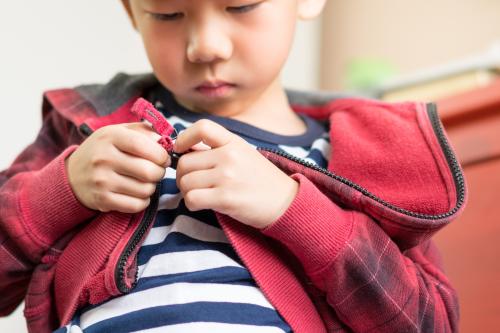
As children engage in practical life exercises - such as lighting and extinguishing a candle, pouring liquid from one container to another, or tying a bow - they concurrently refine their gross and fine motor skills and eye-hand coordination. They learn to synchronize their movements. Many Montessori environments feature an old-fashioned washboard for children to develop their gross motor skills.
These activities serve as vital preliminary exercises that form a solid foundation for writing. Before children even hold a pen, they hone their fine motor skills using these educational materials.
Dangerous Materials for Young Children?
Montessori environments occasionally feature items commonly considered risky. For example, at Centrum Edukacji Montessori in Gdynia, children utilize a real iron, albeit set at a very low temperature with a locked control knob to prevent it from being turned up. At the Montessori Village School in Waidhofen, Austria, older children operate a drill, always under supervision. Montessori classrooms worldwide, such as in Zhongshan, include glass and metal objects to provide a sensory experience. Accidents like a broken glass jar are seen as learning opportunities, fostering greater care in the future.
From a Montessori perspective, it's better to allow children to handle such objects under supervision than to let them experiment with them secretly.
Sensory Materials
Hans-Dietrich Raapke, author of a book on Montessori, portrays our world as one that is sensorially hostile, as it "reveals itself through button-pressing, lever-pulling, and key-operating." While our distant senses of sight and hearing are constantly stimulated, leading to sensory overload, our close senses of smell, taste, touch, and balance are underused. Hence, it's crucial for children to engage these senses through physical sensory experiences.
Sensory materials are designed to render abstract attributes such as sound, color, and weight tangible, like the classifications of short/long, small/large, or rough/smooth. It is through hands-on manipulation that these characteristics are first comprehended before being rationally understood. This practice not only refines the children's sensory perception, but it also allows them to recognize the laws of the real world.
Dimensions
Red rods
Red rods offer a way to introduce the concepts of "long" and "short." These rods vary in length, from 10 cm to 100 cm, increasing in increments of ten, with different weights. Children can compare the length of the rods with objects in their surroundings.
Brown stairs
The brown stairs are ten cuboids of equal length but varying in height and width. When arranged correctly, the result is a staircase with each step one centimeter higher and wider.
Through these prisms, children learn to differentiate the opposite pairs "thick" and "thin" as well as "high" and "low."
The Pink Tower
Perhaps the most iconic Montessori learning material, the Pink Tower, appeals to three-and-a-half-year-old children who typically favor pastel colors (for the psychology of colors, see our article "Why Is This Tomato Black? On the Psychology of Colors and Their Effect on Parents and Children"). Comprising ten cubes ranging in volume from 1 cm³ to 10 cm³, the Pink Tower is built by the child under the guidance of an educator.

The child transports the cubes from the pile to the workspace, noticing the increasing weight. Once the largest cube is placed in the center, the child stacks the remaining cubes in descending order. Upon completion, the child and educator admire the tower before the child is allowed to reconstruct it multiple times. The activity ends with returning the materials to their place - an important aspect of working with learning materials.
The Pink Tower introduces children to three dimensions: length, width, and height. It also prepares them for future volume calculations, having gained a sensory understanding of different volumes.
Insert Cylinders
Insert cylinders are round blocks, with a knob on top for grasping, arranged in sets of ten. They come in four variations that manipulate height and diameter, teaching children to discern "low" and "high", "thick" and "thin", "big" and "small", "narrow" and "wide". These cylinders also serve as excellent fine motor skill exercises, laying the groundwork for future writing or drawing skills.
Color
Color tablets introduce children to a spectrum of colors, shades, and hues. By pairing tablets of the same color, children learn basic and mixed colors and can compare these colors to objects in their surroundings. Early detection of color blindness in children is possible using these color tablets.
Shape
Geometric solids facilitate the differentiation of shapes. These include a sphere, ovoid, ellipsoid, pyramid, cylinder, cone, cube, cuboid, and prism. All objects are painted blue and are tactilely pleasing. Children, after the educator's demonstration, can blindfold themselves and individually feel the shapes. The children also learn which bodies tilt, roll, or both.
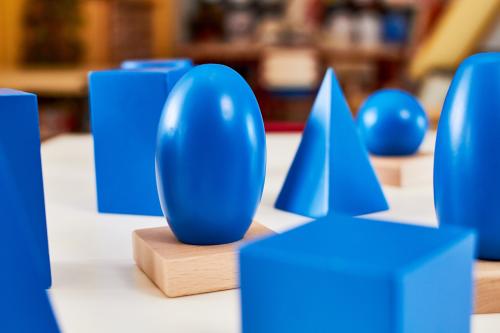
During this activity, the educator might explain that the term "pyramid" originally referred to the Egyptian pyramids, highlighting that learning always correlates with reality.
The geometric solids can be used beyond the preschool setting, particularly when volume calculation is introduced in school. Students build upon their existing knowledge gained through hands-on experiences with these materials.
In all Montessori materials, elements are systematically structured in increments of ten, forming a solid foundation for later comprehension of mathematics.
Structural Textures
To bring structural textures and materials closer to young explorers, tactile boards are used. These tactile boards allow children to feel the quality of a surface and discern different materials with rough or smooth surfaces that are either coarse or fine. Similar to the color tablets, these materials come in pairs, providing an opportunity for children to pair them up.
Perception of Weight
Weight boards, graduated from light to heavy, allow children to experience different weight nuances, promoting a physical understanding of this concept.
Sounds and Tones
Various materials are used to differentiate sounds and tones. Sound cans filled with different substances — some fine, others coarse — provide unique auditory experiences. When shaken, these cans produce different sounds depending on what's inside. Some sounds are quieter, others louder. The sound cans come in two colors, blue and red, each filled with the same contents, which allows children to match the sounds.
Most Montessori classrooms also include bells, allowing children to distinguish different pitches. The children can arrange the bells in order of pitch. Like the color tablets, this didactic material for training the sense of hearing also serves a diagnostic function, revealing potential hearing disorders in children.
Scent Detection
Scent boxes filled with different fragrances help distinguish between smells. These boxes contain absorbent cotton dripped with various essential oils. The child's task is to find two boxes that smell the same. To focus on a single sense, the boxes are designed the same and come in only two colors (two colors per smell) — not multicolored.
Taste Recognition
Taste jars, externally indistinguishable from each other, contain liquids with the flavors sweet, sour, salty, and bitter. Children taste a small amount of liquid dripped onto the back of their hand and match the similar flavors.
Temperature Sensing
With the help of temperature jars, children can perceive temperature differences and learn terms such as "warm," "cold," "hot," and "cool."
As we mentioned earlier, Maria Montessori designed the sensory materials to diagnose the functionality of children's sensory perceptions. For her, as a physician, it was crucial to combine diagnostics and didactics. The goal was to encourage more communication between educators and pediatricians.
Mathematical Materials
While children learn a language intuitively, mathematics requires more structured support. Maria Montessori developed many materials to make this abstract area of numbers and arithmetic operations more concrete. With these, children can experience numbers sensually: They see them and even hold them in their hands.
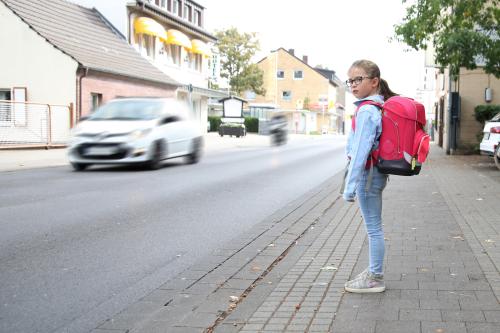
The sensory materials lay the groundwork for preliminary mathematical exercises. For example, a child learns to estimate distances, like how far away a desired apple on a table might be. They gauge height to determine if they can reach the table or calculate the size of an opening they need to crawl through without problems. Even when crossing a street, numerous mathematical operations take place in the brain. A pedestrian estimates the width of the road, the speed of an approaching car, and the required pace to cross the road safely. A child must learn all of this, and the sensory materials provide a solid foundation.
Children aged 4 to 6 love numbers and find the first mathematical exercises highly exciting. There are diverse mathematical materials available for different developmental stages. Here are some examples:
Digits and Chips
Children lay out wooden numbers in the correct order (which they have previously learned). Beneath each number, they place an appropriate quantity of small chips, aligning them in rows. This exercise helps children link abstract numbers with actual quantities.
Hundred Board
Children pour a small bag of numbered plaques onto a mat. These plaques are arranged in order on a grid-like board, starting at the top left with the number one. This activity gives children a sense for tens as they create rows of tens that are arranged one below the other. The exercise also introduces the significance of the number 100.
Golden Bead Material
This material aids children transitioning to elementary school. It consists of ones (a single golden bead), tens (ten beads connected to form a string), hundreds (ten tens connected to form a square), and thousands (a cube made of ten hundreds).
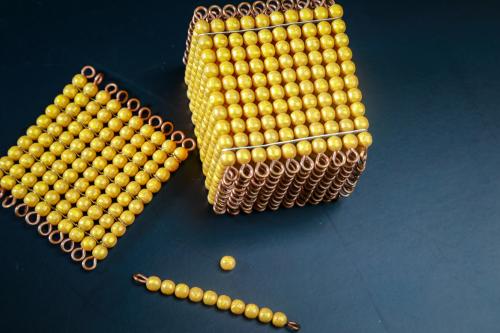
Multiplication and Division Boards
These boards function like a chessboard and allow for various multiplication and division exercises, helping children to physically perform these mathematical operations.
Fraction Material
Fraction exercises become more accessible with the help of fraction disks. The disk is divided into sections representing parts of a whole. This enables children to physically understand what it means to divide a number into fractions.
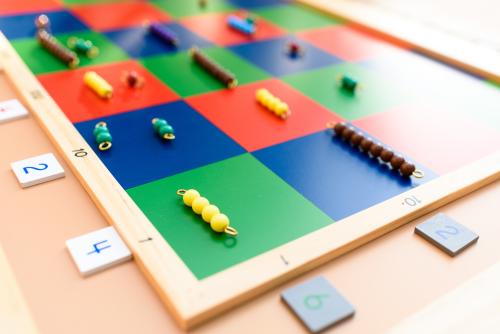
Infinity Exercise
In this activity, a child cuts out a square and attaches a square of the same size next to it to form a rectangle. The child repeats this process, creating larger squares each time, helping to convey the concept of infinity.
Language Materials
Maria Montessori observed a fascinating phenomenon: when children realize they can write, they experience sheer euphoria, seizing every opportunity to express themselves through written words. According to Montessori, we should not stifle this desire by insisting on correct spelling immediately. If a child wants to write "brockoli" before mastering all spelling rules, we should allow them to do so. The mastery of spelling can come later.
Sandpaper Letters
The sandpaper letters, used for memorizing individual letters, feature sandpaper cutouts affixed to square plates, making the letters tangible. The letters are large enough for children to easily handle, and their size also aids children with learning difficulties. There are two distinct colors: one for vowels and another for consonants.
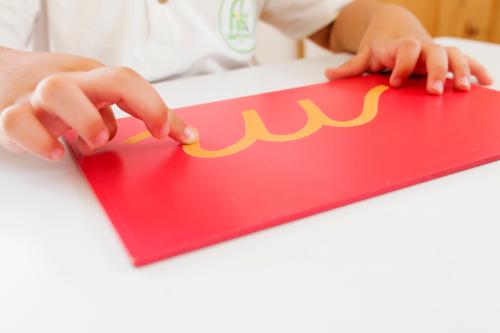
Working with sandpaper letters serves as a preliminary exercise in learning to write and read. In practice, the educator chooses three letters that visually and phonetically differ from each other (for instance, not P and B). First, the educator traces the letter with two fingers and pronounces it. Then the child follows suit. Next, the child is given tasks related to the letters, such as "Clap over the O", "Put the H in the middle", or "Take the M to the kitchen". The more imaginative the task, the better it aids memory. Finally, the child is shown a letter and asked to identify it.
This exercise engages three senses: touch (feeling the letter), hearing (listening to the sound), and sight (seeing the letter).
Vocabulary Exercises
As children start writing, it is beneficial for them to concretely experience the subjects of their writing. Instead of just writing the word "carnation," they should see a carnation in the garden, hold a toy carnation, or at least view a picture of one. This gives an abstract written word a tangible counterpart. The same applies to verbs: when learning these, children should physically perform the action the verb describes. This active learning process more effectively embeds the information in the brain.
Building Vocabulary
Montessori employs various picture cards to help children learn terms from specific word fields, such as tree names. This learning also follows a three-stage process: First, the cards are laid out, and the child names any known trees, setting aside their corresponding cards. Then, three cards remain, and the educator pronounces the tree names depicted. Following this, the educator asks the child to show or tap a specific tree or cover a particular tree with their hand. Lastly, cards are presented individually, and the child is asked, "What tree is this?"
If the child struggles at any step and makes an error, the exercise returns to the previous level.
Initial Sound Basket
In the Initial Sound Basket exercise, children learn that words consist of sounds, each beginning with a specific sound known as the initial sound. From a series of figures kept in a basket, children identify all figures whose initial sound is A, for example: "apple", "ape", "anchor". The educator begins with stretchable sounds such as vowels or an M. Plosive sounds like B or T are introduced later.
Grammar
The materials developed by Maria Montessori make grammar lessons engaging and colorful. Each word type is assigned a distinct symbol in a different color. Children lay out a sentence and match each word with the appropriate symbol. In this way, grammar is absorbed through hearing the word type, seeing the symbol, and touching the symbol while matching.
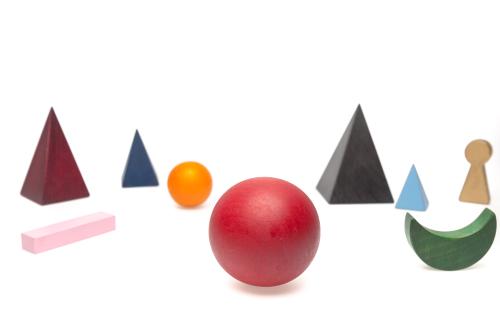
These symbols also demonstrate relationships between words. For example, a verb is represented by a round red circle, while an adverb, related to the verb, is also round but smaller. The noun is a black triangle, and its related parts of speech, such as the article, pronoun, or adjective, are also triangles of varying colors and sizes. Prepositions are represented by an arc, and conjunctions by a connecting line.
This method allows for an enlightening text analysis. After laying out the symbols, does the text contain many large black triangles (nouns), making it seem like an instruction manual or a news article? Or are there many red circles (verbs), rendering the text dynamic, as in a fairy tale? Is the text colorful and linguistically embellished? Does it frequently contain similar symbols in a similar order, indicating a monotonous text structure?
For older children, it would be interesting to compare an artfully written novel, an interview, or a legal text in this manner. Analyzing the same sentence in different languages can also highlight structural differences between languages.
Cosmic Materials
Cosmic education involves materials from science and natural sciences, which children use to understand the world around them. Institutions may use models, conduct experiments, make analogies, or combine these methods, intertwining theory and practice.
The Globe and Other Planets
One famous Montessori material is the sandpaper globe, which allows children to physically feel the continents. In a geography lesson, an educator might start by asking children what they already know about the Earth. Two analogies could be made to explain the Earth's rotation: standing around a campfire where only the front side gets warm, and grilling sausages which need to be turned for even browning.

From these analogies, it's a short leap to the Earth's rotation and the resulting different seasons. The children might consider what would happen if the Earth stopped rotating, possibly concluding that it's fortunate it doesn't!
Other cosmic education materials include a cross-sectional globe, which shows Earth's core, differently-sized spheres to represent the various planet sizes, and a world puzzle featuring different countries that come together to form continents. Once the puzzle is completed, children will have learned all the countries of the world without memorizing them.
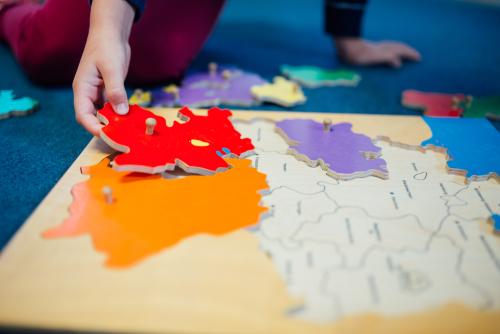
Some Montessori institutions even have materials to distinguish different cloud types.
To help children understand humanity's brief existence on Earth, human evolution is represented as a calendar year: until the end of February, there's no life on Earth; the first living cells appear in early March, and life emerges in the oceans in August. Dinosaurs appear at the end of December but are extinct by Christmas. Two hours before midnight on New Year's Eve, Homo sapiens emerge, and in the last minute, humans as we know them today. Presenting human development in this way could lead to an "aha" moment for children.
The University of Uppsala created an archaeological drawer set to illustrate archaeology, containing models of fossils and other materials like Plexiglas tubes with stones and sand to illustrate the process of sedimentation. Children can walk Earth's history on a floor timeline marking the periods described above.
Beads could represent the world's population growth: one bead symbolizes the world population 6000 years ago, which has now grown to a proud 60 beads. This realization is likely to astonish the children.
The Montessori Education Center in Wiesbaden suggests a demonstration to teach children about water's states of matter: Children fill a glass halfway with water, mark the water level with tape, and freeze the glass overnight. The next day, they marvel at the risen ice level, an outcome most would not have expected.
Movement and Tranquility
Exercises focusing on movement and tranquility are a core component of the Montessori method. Often, no materials are needed to conduct them. Maria Montessori observed that children who are physically active, preferably outdoors, tend to become calmer and engage less in physical altercations. This led her to incorporate ample opportunities for movement into her children's house, even during practical life exercises.
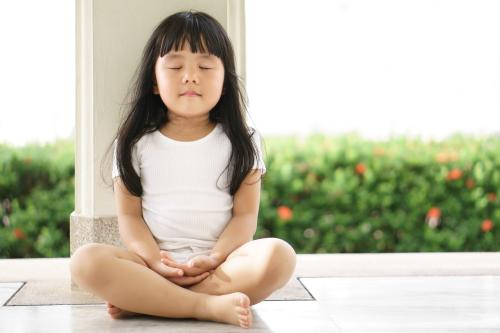
Walking the Line
In addition to physical activities, Montessori incorporated numerous exercises promoting mindfulness and tranquility, such as "walking the line". Beyond physical activity, children require moments of stillness. A variation of this exercise involves children holding a lit candle, which must not be extinguished, or a glass of water, from which the contents should not be spilled. Although challenging, "walking the line" provides a sense of relaxation. Despite requiring concentration, the exercise promotes physical and mental balance.
Another exercise, as described in "Montessori Today", involves children sitting around a large blank sheet of paper, with various materials for painting or collage creation. Their task is to collaboratively produce an image without verbal communication. This exercise enhances mindfulness, non-verbal communication skills, and poses a significant challenge, as children are typically unaccustomed to silence.
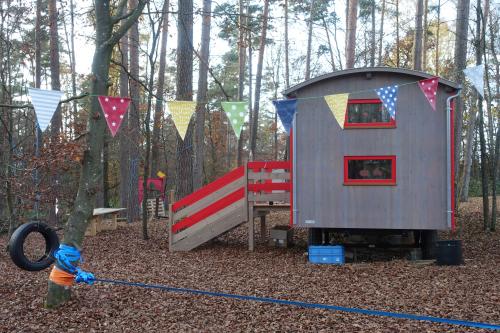
Numerous Montessori schools and children's houses incorporate an open space or playground. Ideally, such facilities would also operate as forest kindergartens. Some children's houses even include a garden, where children plant and care for vegetables and herbs, sweep leaves, and water flowers, thereby honing their gross motor skills and gaining an understanding of food self-sufficiency.
Learning Materials or Toys?
Maria Montessori wasn't a fan of toys, believing children preferred engaging with learning materials over trivial items. However, learning materials and toys aren't mutually exclusive; both can coexist. It's perfectly acceptable for a child to play with toys at home, provided they desire to do so.
If parents wish to provide suitable toys, they should consider the following: the toy should be high-quality and durable. It should not overstimulate, meaning battery-operated, flashing plastic toys may not be ideal. Passive toys, which require creativity and effort, are beneficial as they foster an active rather than passive engagement.
"Our desires preview the abilities within us, heralding what we're capable of. The possible and desirable project themselves into our imagination, detached from us, but situated in the future. We yearn for what we already silently possess. Thus, passionate pursuit transforms the potentially real into the dreamed reality."
Johann Wolfgang von Goethe
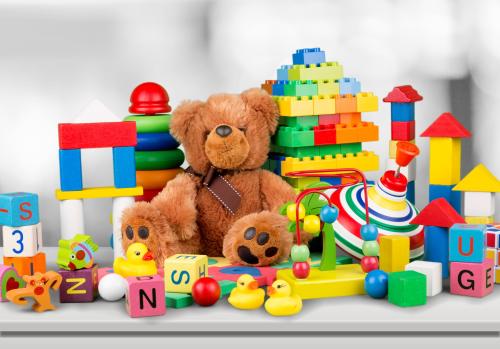
"Coloring books aren't ideal for promoting creativity among children," some Montessori advocates argue. For instance, if a child is coloring a farm, an adult has already defined what a horse, cow, and tree should look like. Rather, a pad and pencils should be provided, allowing children to create animals based on their own imagination.
Learning toys designed to teach children under three years old about numbers or the alphabet may not be suitable. Usually, children signal when they're ready to learn writing or arithmetic independently.
Some strict Montessori followers are opposed to storybooks because they don't accurately represent the real world, but this view is highly controversial.
At QUADRO, we believe children should engage in activities they enjoy, as long as no harm comes to themselves or others. If a child wants to color, why not? It doesn't matter if the pony is pink, the dog orange, and the sun black. The same goes for learning toys - if the child is focused and happy, everything is fine.
Fairy tales, in our view, are acceptable. They inspire the imagination, which can be beneficial for role-playing games. However, we do believe children should avoid toys that serve purely commercial purposes and don't consider the child's abilities.
What distinguishes Montessori materials from toys?
One key difference is that learning materials have a clear beginning and end. A task is completed when the child has successfully accomplished it, possibly after several attempts. This differs from toys, which have no clear beginning or end, and children can disengage from them at any time.
While engagement with learning materials is referred to as "work," it's essentially a form of play. Through this form of play, children explore the world around them and continue to learn in a purposeful and constructive manner.
If you're interested in exploring more about the Montessori world, please read our article, "Learning for Life - A Look at Education According to Montessori Principles".
All sources can be found at the end of the article "Learning for Life - a Look at Education According to Montessori Principles".
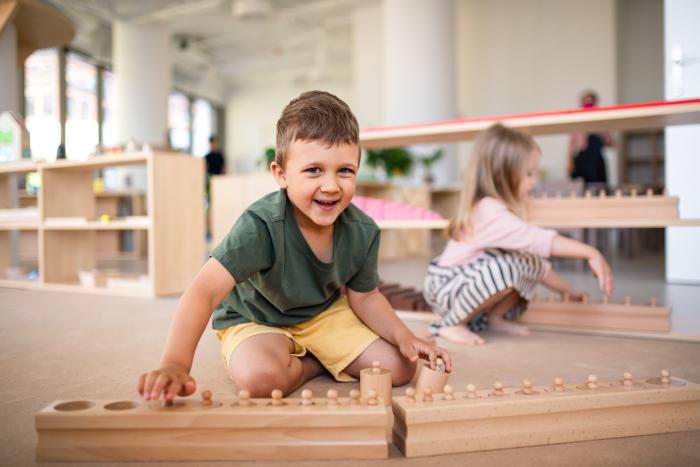
Comments